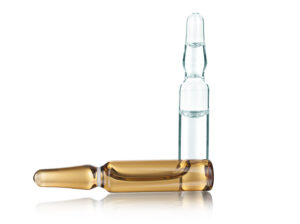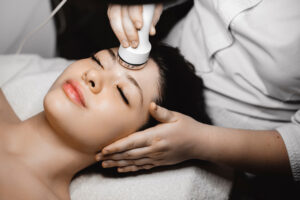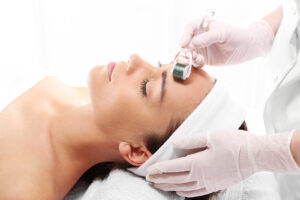Infusing ingredients in the cosmetic treatment: What can and cannot be done
We find the words “skin infusion therpy” enchanting. Infusing products/ingredients is one of the cornerstones of traditional, and modern technology-based cosmetic treatment. This can assume many forms: Moisture infusion, vitamin infusion, infusion through massage or by using advanced devices. To what degree does the cosmetologist truly understand the ability to ”infuse” ingredients into the skin, the clinical rationale, and the well-founded data on the topic?

Numerous procedures, which the cosmetologist conducts at the skincare clinic, are traditional procedures she learned at school and which she has since encountered in various versions in training sessions as well. Often, she accepts the instructions without question and performs all the steps without requiring proof of the necessity of each step. A wealth of information, passed down from generation of cosmetology teachers to generation of cosmetology students, is still continuing from 30 years ago and longer, without the students daring to question what the teacher says or asking proof for the “information” they receive. The examples are numerous. One of the basic topics illuminating the erroneous perception and the lack of vital information is “skin infusion”. Under the title of “infusion” we can list different forms of infusing ingredients to the skin, in a way that we think that the client cannot and will never be able to achieve on her own at home. Since the cosmetologist’s added value is in the results that only she can achieve for the client, which the client cannot achieve on her own, the cosmetologist will seek out these types of treatments. Procedures such as: “moisture infusion”, “vitamin infusion”, infusing ampoules, and non-invasive methods to infuse a variety of ingredients that she is familiar and unfamiliar with – to the skin. Let us investigate all these procedures, which have landed themselves a place of honor in the treatments we offer, and examine our knowledge on the topic, the expectations from the treatments, and the reality.
Moisture infusion
“Moisture infusion” is an action that is conducted in numerous cosmetic treatments. These words lead us to erroneously think that we have affected the moisture level in the client’s skin, and that we have changed its ability to retain water or changed its hydration. After all, we “infused” moisture to it.

The skin’s moisture does not or iginate from an external source. Water in the skin comes from the actual skin, and we have enough water in our body for our skin to benefit from proper hydration as long as the skin’s composition enables it. The dermis contains huge molecules (hyaluronic acid, GAG’s) that hold large amounts of water in the skin, and are the main source of the skin’s hydration. With age, the amount of these molecules decreases, and with it also a reduction in the skin’s ability to retain water. The way to affect the amount of water the dermis can contain – is not by “infusing water” using a galvanic facial machine, or via a moisturizing cream or other external method. The way is to affect the amount of these molecules in the skin – to give the skin compounds that boost their production. The epidermis also has a water content, which comes from an internal, not an external, source. The ability of the epidermis to retain water and its ability to prevent water loss through evaporation are also related to the skin’s composition and to unique molecules and compounds in the epidermis. Any amount of water that we “inject” will not last if the skin does not have the ability to retain and preserve it. The right way to hydrate the epidermis is to give it compounds that boost its water retention capability (like NMFs or some kinds of lipids, for example) and compounds that will improve its ability to prevent evaporation. Our customer can apply these ingredients as part of a moisturizer, and they will go exactly where they need to go. Alternatively, we can apply them to the client’s skin at the end of treatment, without the need for special equipment for infusion. We have to be familiar with these groups of compounds and use them whenever we damage the skin’s integrity (peeling, for example), while understanding that we are not infusing moisture but rather helping the skin preserve its moisture. In certain cases, procedures stemming from lack of knowledge, which we pretentiously call “moisture infusion”, can actually be “applying moisturizing cream” (which the client can do at home with the same degree of effectiveness) or applying a gel with the help of a galvanic facial machine, thinking that we watered the thirsty garden and now it’s been quenched. In numerous cases it’s extremely important to apply a moisturizing cream after the treatment, according to the treatment we conducted. We have to check whether it is clear to us when we simply need to apply a moisturizing cream (and any good moisturizing cream will suffice here) and what we think we are capable of doing with products that are presented to us as “moisture infusion”, “hydration mask”, “intensive moisture”, “moisture bath”, and more.
Means versus goals

We will now turn to a much more fascinating topic in our industry, which is infusing vitamins and additional active ingredients deep into the skin, using different methods – from massage to technological devices. There are many misconceptions on this subject, which stem not only from a lack of knowledge. Lack of knowledge is legitimate – the cosmetologist is not a scientist and is not required to be one. The deeper problem in this industry is that you have not been accustomed to being wise consumers of knowledge. It’s easier to accept whatever we are told without demanding proof and also without exercising clinical logic or attempting to examine the logic behind what we are told. Let us see how we perceive the topic of infusing ingredients to the skin. Is this perspective logical, and also – does the reality support what we think? First we have to make an important and comprehensive distinction, which we often do not do – between means and goals. I will demonstrate this with an example: When we buy a drill at a store, in practice we aren’t buying a drill, we’re buying a hole in the wall. If tomorrow I invent a device and call it a “holer”, which can make holes in a wall but more easily/quietly/cheaply than a drill, then everyone will buy a holer and not a drill. This is because no one wanted to buy a drill to begin with. Our need was a hole in the wall. In the world of cosmetology, the clients come to us to achieve a goal (hole in the wall): acne-free skin, skin that is clear of hyperpigmentation, fewer enlarged pores, smoother and more even skin. Smooth skin is a treatment goal. Acne-free is a treatment goal. Lightening hyperpigmentation is also a goal. Is “infusing ingredients” a goal? Or a means? All the goals we listed above are visible. Some can also be measured with equipment. What measurable or visible change will we achieve by “infusing ingredients”? Numerous cosmetologists refer to infusing ingredients as a goal (like a hole in the wall) and not as a means. This causes them, for example, to buy all the equipment, every magic product, every ampoule and every method to “infuse ingredients” without actually determining what the treatment goal is here. What exact change do we expect to get in the appearance or behavior of the skin. For them, the goal is “infusing ingredients”.
Vitamin infusion
Now, when we made this basic distinction between means and goals, and understand that our clients aren’t interested in infusing ingredients (she doesn’t see “infusing ingredients” at the end of the treatment and doesn’t come to us for this. She came to us to achieve a change in the skin), we’ll ask more questions. Have we defined what our goal for infusing ingredients is, and if we have, do we have proof that infusing ingredients does indeed constitute a tool to achieving this goal?
Let us consider infusing ingredients, starting with the simple and easy to grasp. The easier topic is “infusing” vitamins (and other ingredients, some of which we bought without knowing what they really do) – using facial massage. Do you have a good understanding of what the active ingredients are in each formula or ingredients you are “infusing”, what the concentrations are, what the goal of this infusion is, and is it really achieved as a result of this compound? In expensive compounds, like various ampoules, it’s worth checking. There are many cheap alternatives to these ingredients, which we don’t identify because we don’t have a clue what the ampoule contains and what each ingredient does. If we speak in terms of goals, we have to first define the goal and then see if the way to achieve it by “infusing” vitamins. The right word, by the way, is “applying” vitamins. Our massage does not infuse the vitamins any deeper than what the client would if her skin underwent regular treatments and peeling. Sometimes it seems to the cosmetologist that the vitamins she “infuses” at the skincare clinic are more “concentrated” than what the client has access to at home, but this is also a fundamental error in understanding: With active ingredient concentrations, more is not always better. Every active ingredient has the dosage, or range of dosages, where the ingredient is active (as demonstrated in scientific studies). If we applied the right concentration at the skincare clinic, and the concentration we gave to the client to take home is lower – then we gave her a serum or cream that isn’t really effective. And if the concentration we gave her for at-home use is similar to the concentration we used at the skincare clinic, then we applied vitamins. Exactly like she will continue to apply at home on a daily basis. Our one application did not change the skin’s fate, so it doesn’t justify the investment in expensive products. When is it worthwhile to apply vitamins at the skincare clinic? After irritating procedures, such as peeling – in response to the irritation we caused to the skin. Irritation causes the release of free radicals in the skin, and topical antioxidants are an immediate and wise solution to it. A vitamin serum may also be suitable, provided that it contains the right concentration of vitamins. The vitamins don’t have to be in an ampoule, because, to reiterate, “more concentrated” is meaningless. The right dosage is what’s important. No more and no less.
Infusing ingredients deep into the skin
The more fascinating infusion subtopic is invasive infusion (medical cosmetic mesotherapy) and non-invasive infusion (different devices) of vitamins and hyaluronic acid to the skin. Here I also have to take you back to the basic distinction between means and goals. Mesotherapy is not a goal. Infusing vitamins and hyaluronic acid is not a goal. These are the (not always pleasant) means to achieving a goal. We have to define the goal in order to check whether the means is necessary. At this stage, if we ask you to write down a goal or reasonable goals, some of you will realize that you didn’t give it enough thought. In fact, we didn’t really do an in-depth check of what the goal is here, but if we are already discussing it then we can raise a few treatment goals. Most of the goal suggestions will be: improving the skin’s firmness, improving the skin’s texture, rejuvenating the skin, treating hyperpigmentation. Has anyone asked for proof of a (scientifically proven) causal relationship between skin infusion therapy and these goals? Where is the logical relationship between “infusing vitamins and amino acids and hyaluronic acid” and these goals? At first it may sound logical, but let us think a little. Let us use clinical logic, before we also check the scientific literature to get a proven answer. What exact skincare goal do we achieve by applying a large amount of vitamins in one go? What is the advantage of a massive infusion of vitamins over daily application of the same vitamins, by the client at home? Do we know about warehouses in the skin that receive this quantity, and is later released from them by a tiny warehouse workers, every hour, every day, according to the skin’s needs? Science is unfamiliar with such warehouses. The skin’s physiology, similar to the body’s physiology, is such that it needs every day, hour by hour, substances that allow it to function. Just like you can’t work out at the gym for one day a month, for four months, and expect to be fit for years to come – you can’t give your skin four monthly applications of mesotherapy to change the skin’s fate for years to come. Vitamins, minerals, amino acids – are all an inseparable part of the skin, which it needs on a daily basis and not in concentrated “loads”. Do any of you know how much vitamin C your skin needs, in a one-time “injection”? No one actually knows. It hasn’t been tested. Science knows a lot about how much vitamin C (and dozens of additional ingredients) is necessary when they are applied topically, in a known concentration, the skin on a daily basis. This is how science tested the necessary concentrations of each vitamin or active ingredient – using trials with a regular application – topical application (and not injection) on the skin, every day, for a period of time. No one knows what happened to the ingredients that were “infused” to the skin via mesotherapy using needles or skin-infusing device. The distribution, absorption, clearance, or benefit are unknown.
A very basic and additional question that we must ask ourselves: Can the same ingredients, which we tried to infuse using equipment, also penetrate by simply applying with the hands? Because many ingredients that are marketed to us as cocktails for introduction, are small and permeable molecules. Vitamins, amino acids, minerals, and biomimetic peptides – all penetrate with a simple application.
But since our goal was not really an infusion, the more important question is: which of the therapeutic goals we defined for ourselves, can be achieved through a one-time application (it doesn’t matter if in the clinic or at home) of each of these ingredients? After all, the client does not come to us for treatment every day. And these ingredients were found to be effective only when applied daily, usually twice a day. Can injecting vitamin C or A once in a while be useful for (a goal we may have defined)? Is there any significance to the one-time infusion in the clinic of a biomimetic peptide? Or of any of the minerals or ingredients that are part of the cocktail?
And if we ask this from another angle: which of the ingredients you thought of injecting/infusing, in the clinic, is – a. Too large to penetrate by normal application with the hands, b. Can benefit the skin by applying once every 3 months or once?
In fact, a search through scientific databases only yields a few objective articles about medical-cosmetic mesotherapy for infusing cosmetic compounds. They show that no change occurred in the skin’s characteristics, which were tested after half a year of treatments (collagen density, changes in the elastin fibers, texture, firmness, skin tone, and more). There is no science on mesotherapy for cosmetic needs using devices such as ultrasound or electroporation, and no proof of its ability to (here we have to define a goal, but none was demonstrated or tested).
Additional questions
There are further questions the cosmetologist will have hard time answering: What are the changes that ultrasound wave makes to the actual active ingredient she is trying to infuse to the skin? Does she know how much of it remains active? Numerous substances undergo a change in their structure and activity when exposed to ultrasound. Does she know the composition of the product she is trying to infuse to the skin? Does she know, beyond the active ingredients, how many preservatives, thickening agents, stabilizers, and other ingredients there are, which don’t belong deep in the skin? And again, is there proof of the relationship between infusing the ingredients you have and (the goal you set, if you set one)?
Two important facts should be reiterated here. One – the hyaluronic acid that is infused in medical mesotherapy and using cosmetic devices – quickly breaks down in the skin. It has a half-life of 5 hours (within 5 hours half of it breaks down. Up to 10 hours of its penetration all of it has been broken down). It won’t remain part of the skin, and it doesn’t resemble the substance that is injected for wrinkles. Another reminder is that the beautiful effect that is visible after such a treatment is not a permanent effect. It’s not firming, it’s edema caused by the accumulation of water in the tissue, which gives it a tight and beautiful appearance, for a day or two.
Dermaroller or Meso-pen for skin renewal
The final topic I will mention, which deserves separate discussion, is using a needle roller to infuse substances. The same lack of clinical logic that was mentioned before (and the same lack of scientific proof) exists here as well. However, using a roller – without infusion – is an established and essential tool for improving skin texture and function. Studies demonstrate the efficacy of using a roller for skin renewal, treating scars, enlarged pores and more. The use demonstrated for it was not accompanied by “infusion” of ingredients that were applied under the roller. This device and the method – are effective thanks to the controlled injury of the skin, which causes a real change and not due to the ingredients that were “infused” with it.
